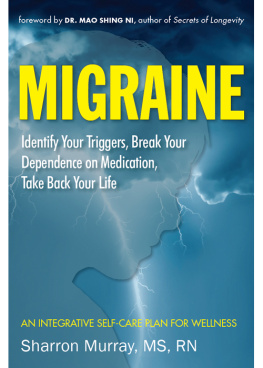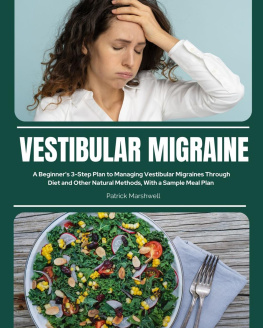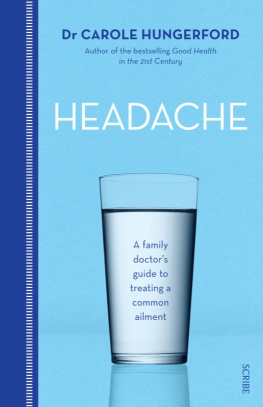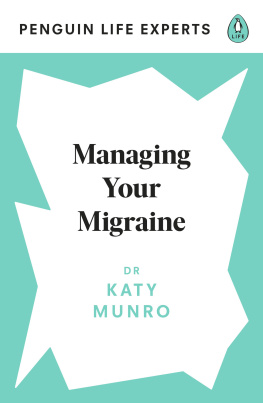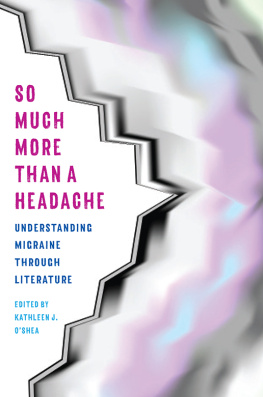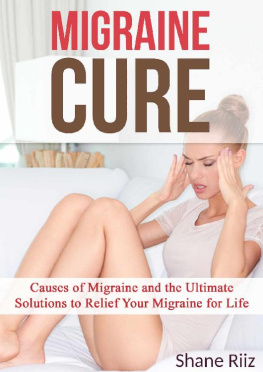First published in 2013 by Conari Press, an imprint of
Red Wheel/Weiser, LLC
With offices at:
665 Third Street, Suite 400
San Francisco, CA 94107
www.redwheelweiser.com
Copyright 2013 by Sharron Murray, MS, RN
All rights reserved. No part of this publication may be reproduced or transmitted in any form or by any means, electronic or mechanical, including photocopying, recording, or by any information storage and retrieval system, without permission in writing from Red Wheel/Weiser, LLC. Reviewers may quote brief passages.
Library of Congress Cataloging-in-Publication Data
Murray, Sharron E.
Migraine : identify your triggers, break your dependence on medication, take back your life : an integrative self-care plan for wellness / Sharron E. Murray, MS, RN.
pages cm
Includes bibliographical references and index.
ISBN 978-1-57324-595-1
1. Migraine--Popular works. 2. Migraine--Alternative treatment--Popular works. 3. Self-care, Health--Popular works. I. Title.
RC392.M92 2013
616.8'4912--dc23
2013000159
Interior by Frame25 Productions
Printed in the United States of America
WOR
10 9 8 7 6 5 4 3 2 1
The paper used in this publication meets the minimum requirements of the American National Standard for Information SciencesPermanence of Paper for Printed Library Materials Z39.48-1992 (R1997).
www.redwheelweiser.com
www.redwheelweiser.com/newsletter
To my husband, David
For loving me through sickness and in health and supporting
me in everything I do. You are the half that makes me whole.
This book is not intended as a substitute for medical advice. If you have any specific concerns about your health or nutrition, please consult a qualified healthcare professional.
The greatest wealth is health.
Virgil
Contents
Foreword
Pain is a dreaded human experience. It is said that most people make choices in life to either seek pleasure or avoid pain. For people with chronic debilitating pain, the pain robs them of the pleasures and quality of life. This is especially true with people who suffer from migraine.
In nearly 30 years of caring for patients with acupuncture and Chinese medicine, I've seen firsthand how during an acute attack the lives of my migraine patients simply stop. Alone in a dark room, they suffer with indescribable pain, dizziness, vision loss, nausea, and vomiting, praying for an end to the episode, and sometimes, in moments of despair, an end to it all.
Thank goodness for medication and thank goodness for acupuncture, for these have been the salvation for many of my migraine patients. Sharron Murray is one such patient who relentlessly sought out cures from East and West and found relief at last with integration of both.
Her journey was one of open-minded exploration. Expanding beyond her comfort zone and the boundaries of conventional Western medicine into Eastern medicine, and moving from a focus on disease to a focus on her whole self and ultimately her life, she found ways to address the physical as well as the mental and spiritual all at once.
Along the way, Sharron discovered that healing comes from within and that patients must take responsibility for their own health and that doctors are guides to activate the inner healer in each one of us.
With a background as a registered nurse and former college professor, which abundantly equipped her to teach and share complex medical subjects in an easy-to-digest format, Sharron has shared her triumphant story in a successful self-help regimen that she has put together as a self-care plan geared to assist other sufferers achieve wellness. The book is a meticulously researched, easy to understand, and essential resource that I am certain will help millions of migraine sufferers take back their lives.
Dr. Mao Shing Ni
Author of Secrets of Longevity and Secrets of Self-Healing and cofounder of Tao of Wellness and Yo San University of Traditional Chinese Medicine (www.taoofwellness.com)
Acknowledgments
There are two people I must thank for helping me gain control of my life and my disease. First, Dr. Richard Byrd, my internist, who started me on a path to wellness by making me confront my dependence on medication. Second, Dr. Mao Shing Ni, who taught me that healing comes from within and one must take responsibility for his/her own health.
I have been blessed to have the support of both doctors as they worked with me over the years to help me achieve the mental, physical, and spiritual wellness I now enjoy.
As well, I thank both doctors for taking time from their busy schedules to review the manuscript as I wrote each chapter, and for sharing their knowledge and offering encouragement. A special thank-you to Dr. Mao Shing Ni for guiding me through my journey into Eastern medicine and for contributing the Foreword to this book.
I extend a special thank-you to Caroline Pincus. Her expertise as an editor has brought this book to life and enabled me to share the contents with you, my fellow migraineurs, as a self-care plan. It is my greatest wish that, as you read through the pages, you gain the inspiration and knowledge you need to plot your own path to wellness.
Introduction
Migraine, a genetic, neurological disease, affects the lives of millions of people worldwide. For many of us, the majority being women, the relentless headache, a symptom of the disease, is excruciating and accompanied by debilitating bouts of nausea and vomiting.
Without a cure, or magic pill, thank goodness researchers and experts continue to focus on the physiological cause of our disease and the best medications to treat our headaches and nausea. However, medication, as I've found out, is not the only answer.
The disease involves much more than our heads and stomachs. It affects our bodies, minds, and spirits. In the throes of a severe attack, often during the very busiest years of our lives (twenties to fifties) when we're balancing our jobs, family responsibilities, and social obligations, our existence stops. Swallowing whatever drugs we can keep down, we're confined to a dark room until the episode is over. Feelings of helplessness and loss of control are prevalent.
Like me, you may have become a victim of medication overuse and rebound headaches because the drugs you take, whether over-the-counter (OTC) or prescription, allow you to make it through these horrific episodes and function as a spouse, partner, parent, aunt or uncle, cook, housekeeper, employee, stay-at-home parent, or friend. Unfortunately, just like me, to maintain the roles you juggle and keep on with the demands of your life, you may have been reluctant, or unable, to acknowledge your dependence on medication, change your lifestyle, take time for yourself, and reduce the effects the stress you impose on yourself has on your body.
After suffering from migraine headaches since I was five years old, and running on fumes for too many years to count, I managed to make it until my early fifties before I was forced to take responsibility for my life and my disease. In the years prior, I had been diagnosed with hypothyroidism in my twenties and, in my forties, a severe neck injury, along with mitral valve prolapse, a condition in which the valve between the upper and lower chambers on the left side of the heart does not close properly. In addition, I suffered from severe bouts of endometriosis and frequent episodes of sinusitis. All of these disorders magnified my migraine attacks, and the headaches were so horrific that many times I prayed to God that if he was going to take me, make it quick.
Thank goodness, in my early forties, I was referred to a migraine clinic. I learned about triggers (things that set off a migraine), how to deep breathe and meditate, and was told to pace myself. The designer drug, Imitrex, had just been introduced, and I took part in a clinical trial. To my delight, I discovered that if I took Imitrex each time I sensed a migraine on the horizon, I could get up at 4 a.m., make it to the hospital and teach students two days a week; and on the remaining days, plan and deliver lectures be it for a class or a consultant opportunity, travel across the city to gather research for a tenured professor, complete my graduate studies, finish my thesis, fulfill my obligations as a wife, and host a number of guests, including my nieces who often stayed for long periods of time and my nephews and their friends, all without drowsiness or nausea. For a few years, I thought I had my miracle cure.
Next page
